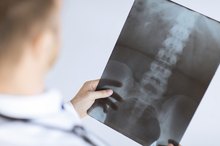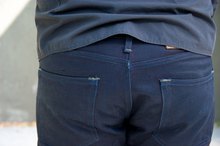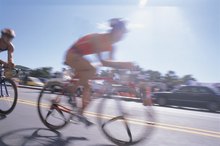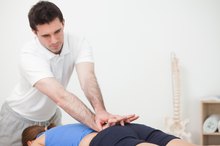Tailbone Injuries & Exercise Bikes
Five small bones at the very bottom of your spine may become painful after prolonged exercise on a stationary bicycle. Your coccyx, or tailbone, is not always in a comfortable position on a small seat of an exercise bike. Doctors do not have a way to cast this area if you do injure it, so prevention is important.
If you are experiencing serious medical symptoms, seek emergency treatment immediately.
The Spine
Your spinal column begins at the atlas and axis bones in your neck. Below this, you have the cervical vertebrae, then the thoracic vertebrae, and your lower back contains the lumbar vertebrae. Your sacrum follow the lumbar vertebrae and contains five fused bones in the shape of a triangle. At the very bottom of the spine are the five smaller bones of your coccyx or tailbone. Typically this area is protected by your gluteal muscles, but when you sit on a narrow exercise bike seat, you apply pressure directly to your tailbone.
- Your spinal column begins at the atlas and axis bones in your neck.
- At the very bottom of the spine are the five smaller bones of your coccyx or tailbone.
Exercise Bike
How to Treat Pelvic Hairline Fracture
Learn More
If indoor cycling is an activity you enjoy, you probably spend a few hours a week on the bike. This repetitive action could lead to a tailbone injury. While numerous websites and blogs have personal stories regarding pain from bicycle seats, clinical documentation is quite limited. In 2006, the American Journal of Physical Medicine and Rehabilitation reported on a 70-year-old woman who incurred tailbone pain from repetitively sitting on a narrow stationary bicycle seat 1. She continued to feel pain whenever seated, even after stopping her cycling routine.
- If indoor cycling is an activity you enjoy, you probably spend a few hours a week on the bike.
Injuries
Injuries to the tailbone may present themselves as fractures, sprains, infections, tumors or degenerative changes. Injuries that result from an exercise bike appear to be an overuse injury. Even when your body is positioned far back on the seat so that your sit bones bear most of the weight, pressure can still occur on your tailbone.
Solutions
Bicycle Seat & Nerve Damage
Learn More
If you suffer a tailbone injury from indoor cycling, rest from cycling will be required. Some sufferers may opt for chiropractic manipulation, using supportive pillows or pain injections. On the bike, you do have seat options that are designed so you feel no pressure in your tailbone. These seats have a cut out area underneath your tailbone. A wider seat that distributes your weight evenly across your rear may also be helpful.
- If you suffer a tailbone injury from indoor cycling, rest from cycling will be required.
- A wider seat that distributes your weight evenly across your rear may also be helpful.
Cross Training
Once your tailbone has healed and you are ready to resume your exercise program, you might enjoy a cross-training workout. Instead of indoor cycling every day, choose a standing exercise such as walking or stairclimbing for one of your workouts. Swimming is another option that will not cause any pressure on your tailbone area. When you cross train with various types of workouts, you avoid overuse injuries.
- Once your tailbone has healed and you are ready to resume your exercise program, you might enjoy a cross-training workout.
- Instead of indoor cycling every day, choose a standing exercise such as walking or stairclimbing for one of your workouts.
Related Articles
References
- American Journal of Physical Medicine and Rehabilitation: Successful Injection for Coccyx Pain
- Spine Universe: Coccydynia: Tailbone Pain
- Coccyx: Cyling for People with Coccyx Pain
- Blocker O, Hill S, Woodacre T. Persistent coccydynia--the importance of a differential diagnosis. BMJ Case Rep. 2011;2011:bcr0620114408. doi:10.1136/bcr.06.2011.4408
- Foye PM, Abdelshahed DM, Kamrava E, Enriquez R, D'onofrio GJ. Tailbone Pain from Coccyx Injuries on Water Slides: A Case Series. J Emerg Med. 2018;55(2):e33-e35. doi:10.1016/j.jemermed.2018.04.033
- Young JD, Gelbs JC, Zhu DS, Gallacher SE, Sutton KM, Blaine TA. Orthopaedic Injuries in Equestrian Sports: A Current Concepts Review. Orthop J Sports Med. 2015;3(9):2325967115603924. doi:10.1177/2325967115603924
- Márquez-carrasco ÁM, García-garcía E, Aragúndez-marcos MP. Coccyx pain in women after childbirth. Enferm Clin. 2019;29(4):245-247. doi:10.1016/j.enfcli.2019.01.005
- Gonnade N, Mehta N, Khera PS, Kumar D, Rajagopal R, Sharma PK. Ganglion impar block in patients with chronic coccydynia. Indian J Radiol Imaging. 2017;27(3):324–328. doi:10.4103/ijri.IJRI_294_16
- Faubion SS, Shuster LT, Bharucha AE. Recognition and management of nonrelaxing pelvic floor dysfunction. Mayo Clin Proc. 2012;87(2):187–193. doi:10.1016/j.mayocp.2011.09.004
- Uglialoro AD, Beebe KS, Hameed M, Benevenia J. A rare case of intraosseous benign notochordal cell tumor of the coccyx. Orthopedics. 2009;32(6):445. doi:10.3928/01477447-20090511-22
- Nunes LF, Castro Neto AK, Vasconcelos RA, et al. Carcinomatous degeneration of pilonidal cyst with sacrum destruction and invasion of the rectum. An Bras Dermatol. 2013;88(6 Suppl 1):59–62. doi:10.1590/abd1806-4841.20132140
- Dudareva M, Ferguson J, Riley N, Stubbs D, Atkins B, McNally M. Osteomyelitis of the Pelvic Bones: A Multidisciplinary Approach to Treatment. J Bone Jt Infect. 2017;2(4):184–193. doi:10.7150/jbji.21692
- Saleem S, Aslam HM, Rehmani MA, Raees A, Alvi AA, Ashraf J. Lumbar disc degenerative disease: disc degeneration symptoms and magnetic resonance image findings. Asian Spine J. 2013;7(4):322–334. doi:10.4184/asj.2013.7.4.322
- Jeyarajah S, Purkayastha S. Proctalgia fugax. CMAJ. 2013;185(5):417. doi:10.1503/cmaj.101613
- Lirette LS, Chaiban G, Tolba R, Eissa H. Coccydynia: an overview of the anatomy, etiology, and treatment of coccyx pain. Ochsner J. 2014;14(1):84–87.
- Malanga GA, Yan N, Stark J. Mechanisms and efficacy of heat and cold therapies for musculoskeletal injury. Postgrad Med. 2015;127(1):57-65. doi:10.1080/00325481.2015.992719
- Scott KM, Fisher LW, Bernstein IH, Bradley MH. The Treatment of Chronic Coccydynia and Postcoccygectomy Pain With Pelvic Floor Physical Therapy. PM R. 2017;9(4):367-376. doi:10.1016/j.pmrj.2016.08.007
- Antoniadis A, Ulrich NH, Senyurt H. Coccygectomy as a surgical option in the treatment of chronic traumatic coccygodynia: a single-center experience and literature review. Asian Spine J. 2014;8(6):705–710. doi:10.4184/asj.2014.8.6.705
- Foye PM. Coccydynia: Tailbone Pain. Phys Med Rehabil Clin N Am. 2017 Aug;28(3):539-49.
- Lirette LS, Chaiban G, Tolba R, Eissa H. Coccydynia: An Overview of the Anatomy, Etiology, and Treatment of Coccyx Pain. Ochsner J. 2014 Spring;14(1):84-87.
- Nathan ST, Fisher BE, Roberts CS. Coccydynia: a review of pathoanatomy, aetiology, treatment and outcome. J Bone Joint Surg Br. 2010 Dec;92(12):1622-7.
Writer Bio
A mother of two and passionate fitness presenter, Lisa M. Wolfe had her first fitness article published in 2001. She is the author of six fitness books and holds an Associate of Arts in exercise science from Oakland Community College. When not writing, Wolfe is hula-hooping, kayaking, walking or cycling.









